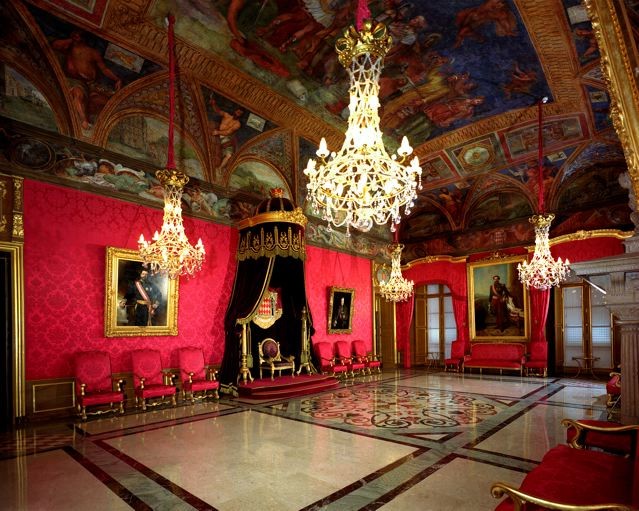Monaco: Coming Up Modern

French writer Colette once remarked that Monaco might be the only country in the world whose borders are marked by beds of brightly colored flowers. There is no show of passports, but you know you’ve left France when the impeccable white-gloved gendarmes salute politely when you stop to ask for directions. While you’re at it, you might as well as smile: the electronic surveillance cameras are virtually everywhere, which accounts for the principality’s astoundingly low crime rate. It’s hard not to notice that the streets are suddenly spotless, devoid of litter. Call it the magic kingdom effect.
Monaco, a country less than two square kilometers, or 500 acres, in area, has been ruled by the Grimaldi family for more than seven centuries. Surprisingly enough, Monaco was once the poorest country in Europe, since nothing could be made from its rocky soil. And then came the Casino: Monaco’s reigning Prince Charles II created a gambling house in 1863 to generate new revenue. When his first attempts failed, he handed the project over to shrewd businessman François Blanc, who acquired it for 1,000,500 French francs—in gold—and wooed the star architect of the Paris Opéra, Charles Garnier, to build Monaco’s legendary Belle Epoque gaming landmark. Blanc also founded the Société des Bains de Mer (SBM), which is still all-powerful today, since the state is its principal shareholder.
In fact, it was only when Prince Rainier III took the throne in 1949 that the real moneymaking began. Add to that Rainier’s highly publicized, fairy-tale romance and marriage with American movie actress Grace Kelly, and the principality’s glittering image was firmly in place.
When Prince Rainier died on April 6, 2005, the Monegasques were in deep mourning for months (black was never so fashionable on the Côte d’Azur), but you could also sense that a page had been turned. Now more than ever, the shy, bespectacled heir to the throne, Prince Albert, has been actively innovating in every domain, particularly in the increasingly more contemporary landscape and arts scene. The worn cliché no longer fits: once considered a tax haven for a glitzy international crowd of wealthy expatriates, there are more reasons now to visit than experiencing the mad uproar of the Grand Prix Formula 1 race. Sure, there are still rows of shiny Lamborghinis and Bentleys parked in the Casino Square, the harbor is still a showcase for mega-yachts, and the SBM alone operates four grand hotels, five casinos, three spas, some 30 bars and restaurants, the Opéra, the golf club and the country club.
However, over the past few years, the impressive number of exciting cultural events and new—and sometimes even affordable—hotel and restaurant openings has spruced up the postage-stamp principality’s tarnished Old World image considerably.
As tiny as it is—considerably smaller than New York’s Central Park—the sovereign state of Monaco is divided into five districts, a source of confusion for many visitors. Best known is glittery Monte-Carlo, perched on a hill to the east of the harbor, home of the mythic Garnier Casino (don’t forget your passport and the required jacket for men) which continues to attract an elegant clientele who plunk down serious money at the roulette tables, or flock to the back room for blackjack and the similar trente et quarante, poker and craps. Even those not tempted by the jangling slot machines should have a peek at the cherub-frescoed ceilings and stately marble columns, well worth the entry price.
The Opera House next door was also designed by Garnier. Its heavily gilded decor—Second Empire lyre-toting angels, mythological frescoes and bronzes, and the Grand Lustre, a 5-ton chandelier of Bohemian crystal—has recently been restored to its former glory, with a schedule that includes more than just their top-notch opera series. Other seasonal events include a new annual Monte-Carlo Jazz Festival (November), featuring some of today’s most famous international jazz artists, and the ultramodern Ballets de Monte-Carlo, headed by choreographer Jean-Christophe Maillot.
Another welcome addition for live music is Moods, a snazzy music bar and lounge, built just under the Café de Paris. There’s no cover charge and you can sip a relatively inexpensive drink, nibble on tapas and listen to groups that range from blues and jazz to rock and electronic.
Aside from the SBM-owned landmark Belle Epoque hotels (splurge for the atmosphere at the gilded bar at the legendary Hotel de Paris or a meal at Ducasse’s sublime Michelin three-star Louis XV therein) there are countless designer boutiques and jewelry shops radiating from the Casino square. Another hotspot is the recently revamped baroque-meets-contemporary Hôtel Métropole, designed by Jacques Garcia. Starry chefs Christophe Cussac and Joël Robuchon, masterminds of the pricey but exquisite tasting-size portions of Mediterranean dishes in the Métropole’s main restaurant, have opened a second gastronomic option called Yoshi. This exquisite contemporary-style Japanese restaurant, headed by Takéo Yamazaki, dishes up ultra-refined platters of sushi, sashimi et maki, plus specialties including a mouthwatering black cod dish, all served with a vast selection of imported fine sake.
Down along the port, La Condamine seems more like a normal Mediterranean neighborhood; the morning open-air markets are where the true-blue native Monegasques (about 6,000 people—roughly 19% of the population) are filling their straw baskets with fresh produce. Duck into a simple café and try the local specialty, barbaguian—a dumpling stuffed with Swiss chard and Parmesan cheese. You may even hear the old-timers speaking the ancient Monegasque dialect, which is also taught in local schools. For the budget-minded, the new three-star Ni Hotel, hidden away on a street above the harbor, is a 17-room gem of contemporary design with two split-level suites, hi-tech amenities and moderate prices.
Along the quay, the restaurants, art galleries, and Yacht Club are always buzzing, but you’ll also see simple fishing boats unloading their catch of the day. Several years ago, the industrial lofts overlooking the harbor were entirely refurbished and now house an international group of artists, including Fernando Botero, Sacha Sosno, and Valerio Adami—it’s something like Monaco’s version of a grunge-less Soho on this hot circle of pricey property.
The latest addition is Zest, an edgy combo of fine food boutique and take-away traiteur, with a spacious lounge, restaurant and lovely outdoor terrace. There’s a dazzling array of Italian gastronomic goodies for sale, ranging from exclusive olive oils, truffle oils, Venetian and Russian caviar, to exquisitely prepared dishes and divine sweets, from nougat to chocolates. Come sunset, the caviar and champagne bar opens for cocktail hour.
Above the harbor to the west is Monaco Ville, also known as the Le Rocher—The Rock—a tiny medieval town of winding cobblestone streets dominated by the Grimaldi’s Palais Princier. The salmon-pink palace is built over a 13th-century Genoese fortress. The white and red banner flying overhead means that Prince Albert II is in residence, and it’s closed to the public—but you still can admire the cannons, which were donated by Louis XIV, and check out the 11:55 am daily changing of guard on the huge square. (In summer there are short guided tours of the throne room and state apartments, and the beautiful inner courtyard is open for classical concerts.) The inevitable tourist shops are designed for camera-toting royalty gawkers, but do see the Rock’s lovely exotic gardens, the stately marble Cathedral and the Oceanography Museum, with an impressive aquarium and shark tank.
At the entrance to the principality, bordering the French village Cap d’Ail, Fontvielle is a concrete sprawl of pricey modern high-rise apartment buildings with a shopping mall and a pretty rose garden dedicated to Princess Grace. Another affordable hotel option here is the Columbus, co-owned by Formula I driver David Coulthard. It was created in 2001 as a chic but reasonably priced “lifestyle” hotel catering to a young international crowd , with cushy leather furnishings, oversized pillows, deep sofas, feather duvets and hi-tech consoles. The convivial bar is celebrity-packed during the Grand Prix.
Finally, near the Italian border, Larvotto is the easternmost strip of sandy beaches, boutiques and restaurants including the Sporting Club, where glittery galas and summer concerts are held. It’s also the center of Monaco’s nightlife, housing Alain Ducasse’s trendy mix-and-match restaurant, Bar & Bœuf and Jimmy’z, the pricey Monegasque disco that’s been an institution since it opened in the 1970s and is still going strong. Depending on the night, you might be brushing elbows with Middle Eastern princes or local mini-skirted jewel-laden shopkeepers, or both.
Farther down the seafront, the Monte-Carlo Blue Bay Resort is Monaco’s most recent 11-story, €50 million extravaganza. Don’t be put off by its Disneylandish diversity (5 different restaurants in season, botanical gardens connected by little bridges, a casino with the latest hi-tech slot machines, souvenir and sportswear boutiques, a private dock and helipad, and two pools—one of them a pretty artificial sand-bottom lagoon). The rooms are contemporary comfy, and nearly all have private sea view terraces. Combined with the exotic Blue Bay restaurant, where chef Marcel Ravin offers an inspired, ever-changing gastronomic menu, and the Cinq Mondes spa, it adds up the best hotel deal in town.
At the end of the strip, the exclusive 40-room Monte-Carlo Beach Hotel recently reopened after extensive renovations, with a contemporary makeover by design star India Mahdavi. Open to the (paying) public as well as guests, the huge pool, posh Sea Lounge and Beach Club are an attractive option to the crowded Larvotto beaches.
Grimaldi Forum, a multi-leveled pyramid of stone and glass, is an ultramodern business and cultural center, hosting the Monte-Carlo Television Festival, the Forum of Cinema and Literature, the computer animation festival Imagina and the avant-garde Dance Forum as well as cutting-edge art shows. Karément, on the mezzanine floor, is a lounge with a flashy post-pop decor and sea view terrace that functions during the day as a high-end snack bar and late at night attracts a mix of the sports, rock and young glam set. Across the street, part of the Nouveau Musée National de Monaco contemporary art collection is housed in the Villa Saubert.
If you’re wondering what you’ll feel like reading, pack Colette’s The Innocent Libertine, one of the author’s early classics. Set in 19th century Parisian bourgeois society, it recounts how the rebellious heroine, Minnie, ultimately finds true love on holiday in Monte-Carlo.
ADDRESSES
Country code for Monaco is 377
Casino de Monte-Carlo Place du Casino 98.06.21.21. website
Opéra de Monte-Carlo Place du Casino 98.06.28.00. website
Moods Place du Casino 98.06.36.36. website
Hôtel de Paris Place du Casino 98.06.30.00. website
Restaurant le Louis XV Hôtel de Paris, 98.06.88.64. website
Hôtel Métropole 4 ave de la Madone, 93.15.15.15. website
Yoshi Hôtel Métropole, 93.15.15.15. website
Jimmy’z 26 ave Princesse Grace, 98.06.73.73. website
Monte-Carlo Beach Hotel Ave Princesse Grace, 98.06.50.00. website
Grimaldi Forum 10 ave Princesse Grace, 99.99.20.00. website
Nouveau Musée National de Monaco Villa Sauber, 19 ave Princesse Grace, 98.98.91.29. website
Originally published in the February 2009 edition of France Today; updated in February 2011
Share to: Facebook Twitter LinkedIn Email



